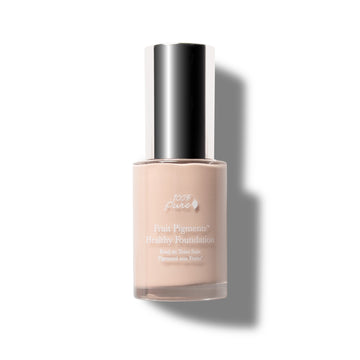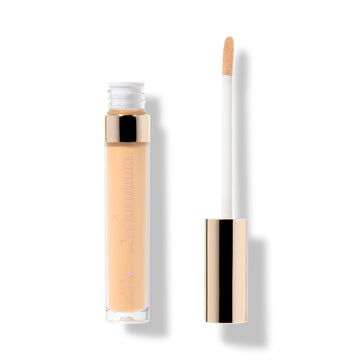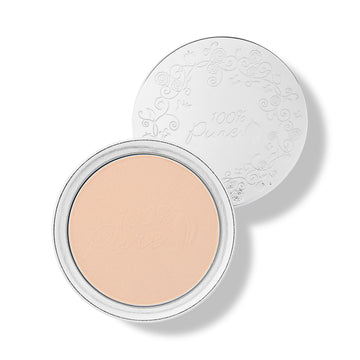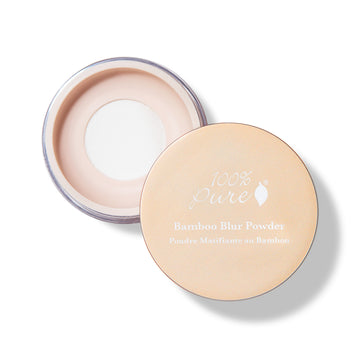Here's how to update your approach for naturally radiant, age-appropriate coverage that enhances your beauty.
Posted on June 13, 2025 Written by: 100% PURE®
After 40, your skin changes in ways that can make your tried-and-true makeup routine work against you. The foundation that looked flawless in your thirties might now emphasize fine lines, settle into pores, or look mask-like. Here's how to update your approach for naturally radiant, age-appropriate coverage that enhances your beauty.
Why Your Old Foundation Routine Isn't Working Anymore
The frustration is real and incredibly common: you apply the same foundation you've used for years, only to find it looks completely different than it used to. What once provided smooth, even coverage now seems to highlight every line, settle into creases, or create an unnatural finish that ages you rather than enhancing your natural beauty.
The truth is that mature skin has fundamentally different needs than younger skin, and these changes require adjustments to both products and application techniques. Hormonal shifts, decreased collagen production, and changes in skin texture all affect how makeup sits on and interacts with your skin.
Many women over 40 continue using the same products and techniques they learned in their twenties and thirties, not realizing that what worked then may actually be counterproductive now. Heavy coverage that once looked polished can appear cakey on mature skin, while matte finishes that controlled oil in younger years can emphasize dryness and texture.
The beauty industry often fails to address these specific needs, instead focusing on anti-aging as if the goal is to look decades younger rather than looking beautiful at your current age. This leaves many women feeling frustrated and confused about how to adapt their makeup routine to work with their changing skin.
Understanding why your foundation isn't working anymore is the first step to fixing the problem. Once you recognize how skin changes affect makeup application and choose products designed for mature skin's needs, you can create a routine that makes you look and feel your absolute best.
The goal isn't to hide your age or create an artificial appearance—it's to enhance your natural beauty, even out your complexion, and create a polished look that feels authentic and age-appropriate. With the right approach, foundation can be your ally in looking radiant and confident at any age.
How Skin Changes After 40 (And Why It Matters for Foundation)
Understanding the specific changes that occur in mature skin helps explain why foundation application needs to evolve and guides better product choices. These changes aren't flaws to hide—they're natural developments that require adjusted techniques for optimal results.
Decreased Oil Production and Moisture Retention As estrogen levels decline, skin produces less sebum, leading to dryness that affects how foundation applies and wears. Previously oily or combination skin may become normal or dry, while already dry skin can become even more dehydrated. This change means that mattifying products that once controlled shine may now emphasize dryness and create a chalky appearance.
Decreased moisture retention also affects skin plumpness and smoothness. When skin lacks adequate hydration, foundation can appear patchy, settle into fine lines, or look powdery rather than smooth and natural.
Loss of Collagen and Elasticity Collagen production slows significantly after 40, leading to changes in skin texture, firmness, and resilience. This creates more pronounced pores, fine lines, and areas where makeup can settle or cake. Traditional full-coverage foundations may emphasize these texture changes rather than creating the smooth finish they provided on younger skin.
The loss of elasticity also means skin doesn't bounce back as quickly from facial expressions, leading to more permanent-looking lines that require different coverage strategies than temporary expression lines.
Changes in Skin Tone and Pigmentation Hormonal changes often lead to increased pigmentation irregularities, including age spots, melasma, or overall tone unevenness. Additionally, decreased circulation can affect natural skin color, sometimes making complexions appear more sallow or dull than in previous years.
These changes mean that foundation shade matching becomes more complex, as you may need different undertones or coverage strategies to address uneven pigmentation while maintaining a natural appearance.
Altered Skin Texture and Surface Mature skin often develops a slightly rougher texture due to slower cell turnover and accumulated sun damage. This can cause foundation to apply unevenly or appear to sit on top of skin rather than blending seamlessly. Additionally, areas of the face may have different textures, requiring customized application techniques.
Increased Sensitivity Many women notice increased skin sensitivity after 40, whether due to hormonal changes, cumulative environmental damage, or thinning skin. This means heavy, heavily fragranced, or chemically-laden foundations may cause irritation or reactions that weren't problematic in younger years.
Understanding these changes helps explain why the best foundation for older skin often differs significantly from products that worked well in younger years. The goal is choosing formulations and techniques that work with these natural changes rather than fighting against them.
The 6 Most Common Foundation Mistakes After 40
Recognizing these frequent mistakes helps identify why your current routine might not be working and provides a roadmap for improvement. Most women make multiple mistakes simultaneously, compounding the problem and creating increasingly frustrating results.
Mistake #1: Using Too Much Coverage Many women assume they need heavier coverage as they age to hide imperfections, but excessive coverage often emphasizes texture issues and creates an unnatural, mask-like appearance. Heavy foundation settles into fine lines, makes pores more prominent, and can actually draw attention to the areas you're trying to camouflage.
The best foundation for older women typically provides buildable, medium coverage that evens skin tone without completely obscuring natural skin texture. Light-to-medium coverage allows skin to show through in a way that looks natural and healthy rather than artificial.
Mistake #2: Choosing the Wrong Undertones Skin undertones often shift with age due to hormonal changes, sun damage, and decreased circulation. Many women continue using the same undertone they wore in their twenties or thirties, not realizing their complexion has changed. This mismatch can make foundation look unnatural, too pink, too yellow, or simply "off."
Additionally, some women try to use foundation to warm up sallow skin by choosing overly warm shades, which often looks obvious and unnatural. The key is finding the right undertone for your current complexion and using other techniques to add warmth if needed.
Mistake #3: Skipping Primer or Using the Wrong Type Primer becomes increasingly important for mature skin, as it helps smooth texture irregularities and creates a better base for foundation application. However, many women either skip primer entirely or use formulations designed for younger, oilier skin that can emphasize dryness.
The Mattifying Primer works well for areas that still produce oil, such as the T-zone, while the Luminous Primer is ideal for areas that need hydration and radiance. Using the appropriate primer makeup for different areas of your face can significantly improve foundation application and longevity.
Mistake #4: Using Powder Incorrectly Powder application becomes more critical and more challenging with mature skin. Too much powder can settle into lines and create a dry, aged appearance, while too little may not provide adequate staying power. Many women also use powders with talc, which can be drying and create an unnatural finish.
A talc free powder like the Bamboo Blur Powder provides setting power without the drying effects of traditional powders. The key is using minimal amounts and focusing application on areas that tend to crease or fade rather than powdering the entire face.
Mistake #5: Neglecting Concealer Strategy The relationship between concealer vs foundation changes with mature skin. Many women either use too much concealer, creating obvious patches of different coverage, or try to make foundation do all the work, leading to overall heavy application.
Strategic concealer use with products like the Fruit Pigmented® 2nd Skin Concealer allows you to use lighter foundation overall while targeting specific areas that need extra coverage. This approach creates a more natural, skin-like finish.
Mistake #6: Using Outdated Application Techniques Application techniques that worked for younger skin may not translate well to mature skin. Rubbing or buffing foundation can disturb delicate skin and emphasize texture issues, while certain brush types may not work as well on drier or more textured skin.
Gentle pressing, patting, and stippling motions often work better for mature skin, allowing foundation to meld with skin rather than sitting on top of it.
The Right Foundation Formulas for Mature Skin
Choosing the best foundation for older skin requires understanding which formulations work with mature skin's characteristics rather than against them. Clean, nourishing ingredients become increasingly important as skin becomes more sensitive and requires additional support.
Hydrating Liquid Foundations Hydrating formulations are typically the best choice for mature skin, as they provide moisture while evening skin tone. The Fruit Pigmented® Healthy Foundation combines coverage with skin-nourishing ingredients that support skin health while providing a natural, radiant finish.
This type of foundation contains ingredients that actually benefit skin over time, unlike conventional foundations that may dry or irritate. The fruit pigments provide natural color while antioxidants protect against environmental damage throughout the day.
Buildable Coverage Formulas Look for foundations that allow you to customize coverage where needed rather than providing uniform heavy coverage. Buildable formulas let you use light coverage over most of the face while adding more coverage only where needed, creating a more natural overall appearance.
The ability to build coverage gradually also prevents the common mistake of applying too much product initially, which can be difficult to correct and often leads to a cakey appearance.
Powder Foundations for Specific Needs While liquid foundations are generally preferred for mature skin, powder formulations can work well for specific situations or skin types. The Fruit Pigmented® Powder Foundation provides a different finish and can be easier to apply for those who prefer powder formulations or need quick touch-ups.
Powder foundations work best on well-moisturized skin and should be applied with a light hand to avoid emphasizing texture. They're excellent for combination skin types where liquid foundation might be too heavy in oily areas.
Primer-Foundation Synergy The combination of appropriate primer and foundation creates better results than either product alone. Primers designed for mature skin address specific concerns like hydration, smoothing, or radiance while creating an optimal base for foundation application.
Using Luminous Primer under foundation adds a subtle glow that makes skin appear more youthful and healthy. This radiance shows through foundation, creating a lit-from-within effect that's particularly flattering on mature skin.
Clean, Nourishing Ingredients Mature skin benefits from foundations with skin-supporting ingredients rather than harsh chemicals that can cause irritation or dryness. Fruit-pigmented formulations provide color from natural sources while avoiding synthetic dyes that can be sensitizing.
These clean formulations are particularly important for sensitive skin, which becomes more common with age. They provide coverage without compromising skin health or causing long-term damage.

Step-by-Step Application for Flawless Results
Proper application technique becomes increasingly important with mature skin, as the right method can make even average products look great, while poor technique can make expensive products look terrible. This step-by-step approach optimizes results for mature skin's specific needs.
Step 1: Prep with Proper Skincare Begin with well-moisturized skin, as hydrated skin provides the best foundation base. Allow moisturizer to fully absorb before applying primer—rushing this step often leads to pilling or uneven application.
Consider using a hydrating serum under moisturizer if your skin is particularly dry, but again, allow full absorption between layers. Properly prepped skin requires less foundation and creates a more natural finish.
Step 2: Apply Strategic Primer Use primer only where needed rather than applying it all over the face. The Mattifying Primer works well in the T-zone for those who still experience oiliness, while Luminous Primer is ideal for areas that need radiance and smoothing.
Apply primer with gentle patting motions, focusing on areas with larger pores or fine lines. Allow primer to set for a minute before applying foundation to ensure optimal performance.
Step 3: Foundation Application with Restraint Start with less foundation than you think you need—you can always add more. Apply foundation to the center of your face first (nose, under-eye area, chin) where coverage is typically most needed, then blend outward.
Use gentle pressing and stippling motions rather than rubbing or buffing. For liquid foundations like Fruit Pigmented® Healthy Foundation, damp beauty sponges often provide the most natural finish by pressing foundation into skin rather than moving it around.
Step 4: Strategic Concealer Application Apply concealer only where needed using the Fruit Pigmented® 2nd Skin Concealer. Focus on specific spots, under-eye discoloration, or areas of redness rather than applying concealer broadly.
Pat concealer gently with your ring finger or a small brush, being careful not to disturb the foundation underneath. The goal is to spot-correct rather than create another layer of coverage.
Step 5: Light Powder Setting Use minimal powder only where needed, typically the T-zone and under-eye area where creasing is most likely. The Bamboo Blur Powder provides setting power without the drying effects of talc-based powders.
Apply powder with a fluffy brush using light pressing motions. Avoid dragging or sweeping motions that can disturb foundation and create an uneven finish.
Step 6: Final Blending and Check Step back and assess the overall result in natural light if possible. Blend any harsh lines and remove excess product from areas where it may have accumulated, such as around the nose or in smile lines.
The final result should look like improved skin rather than obvious makeup. If foundation is visible as a separate layer, use a damp sponge to gently press and blend until it melds with your skin.
Concealer Strategies That Actually Work for Mature Skin
Understanding concealer vs foundation usage becomes crucial for mature skin, as strategic concealer application allows for lighter overall foundation coverage while effectively addressing specific concerns. The goal is targeted correction rather than uniform heavy coverage.
Color Correcting Before Concealing For persistent dark circles or significant discoloration, consider color correcting before applying concealer. Peach or orange tones counteract blue or purple under-eye circles, while green addresses redness. Apply color corrector sparingly and blend well before adding concealer.
This layered approach often provides better coverage with less product than trying to achieve full correction with concealer alone. It also prevents the chalky, obvious appearance that can result from heavy concealer application.
Strategic Placement Techniques Apply concealer in triangular shapes under the eyes rather than just on dark circles. This technique brightens the entire under-eye area and creates a lifting effect. Extend the triangle from the inner corner to the outer corner and down to the top of the cheek.
For spot concealing, apply concealer slightly beyond the edges of blemishes or discoloration, then blend the edges carefully into surrounding skin. This prevents obvious patches of different coverage.
Layering for Natural Coverage Build concealer coverage gradually rather than applying a thick layer initially. The Fruit Pigmented® 2nd Skin Concealer allows for buildable coverage that won't look cakey when layered properly.
Apply a thin layer, blend well, then assess whether additional coverage is needed. This approach prevents over-application and creates a more natural finish than attempting full coverage in one application.
Setting Concealer Appropriately Set concealer with a small amount of powder, but be careful not to over-powder areas with fine lines or dry skin. Use a small, fluffy brush to apply powder precisely where needed rather than dusting it broadly over concealed areas.
For under-eye concealer, consider using a damp beauty sponge to press a tiny amount of powder into the concealer rather than brushing powder on top. This technique sets the concealer without creating a dry, cakey appearance.
Blending for Seamless Results The edges of concealer application are crucial for natural-looking results. Use clean fingers, a damp sponge, or a small brush to blend concealer edges into surrounding foundation and skin.
Pay particular attention to the transition areas where concealer meets foundation. These should be seamless, with no visible lines or patches of different coverage levels.

Powder Application Secrets for Mature Skin
Powder application requires a completely different approach for mature skin compared to younger skin. The goal shifts from oil control and mattifying to subtle setting and finishing without emphasizing texture or creating dryness.
Choosing the Right Powder Texture Talc free powder formulations like Bamboo Blur Powder provide setting power without the drying, aging effects of traditional talc-based powders. These formulations often contain light-reflecting particles that add subtle radiance rather than creating a flat, matte finish.
Finely milled powders work better on mature skin than coarser formulations, as they're less likely to settle into fine lines or emphasize texture irregularities. The particle size should be small enough to blend seamlessly with skin.
Strategic Application Areas Focus powder application on areas prone to creasing or fading rather than powdering the entire face. Typically, this includes the T-zone, under-eye area, and smile lines. Areas like the cheeks and forehead often look better with minimal or no powder.
This selective approach prevents the all-over powdered look that can age mature skin while still providing setting power where it's most needed.
Application Technique for Natural Results Use a fluffy, natural-hair brush to apply powder with gentle pressing motions rather than sweeping or buffing. Pressing powder into skin helps it meld with foundation rather than sitting on top as a separate layer.
For the under-eye area, use a smaller brush or even a damp beauty sponge to apply powder with extreme precision. This area is particularly prone to looking dry and cakey with too much powder.
The Roll-Back Technique After applying powder, use a clean, damp beauty sponge to gently roll over powdered areas. This technique removes excess powder while maintaining setting power, creating a more skin-like finish.
This step is particularly important if you've applied powder to areas with fine lines, as it helps prevent the powder from settling into creases throughout the day.
Setting Spray Considerations Consider using a hydrating setting spray after powder application to add moisture back to the skin and create a more natural finish. This step can counteract any drying effects from powder while improving overall longevity.
Choose setting sprays with hydrating ingredients rather than alcohol-based formulations, which can be too drying for mature skin.
Building Your Perfect Mature Skin Foundation Routine
Creating a personalized routine that works consistently requires understanding your specific skin type, concerns, and lifestyle needs. The best foundation for older women varies significantly based on individual factors, but certain principles apply universally.
Assessing Your Current Skin Type Your skin type may have changed significantly since your younger years, so reassess honestly. What was once oily skin may now be normal or even dry, while combination skin patterns may have shifted to different areas of the face.
Consider seasonal variations as well, as mature skin often becomes more reactive to weather changes. You may need different products for summer and winter or different application techniques based on climate conditions.
Creating Your Product Arsenal Build a collection of products that can be mixed and matched based on your daily needs. This might include:
- Mattifying Primer for oily areas and Luminous Primer for areas needing radiance
- Fruit Pigmented® Healthy Foundation as your primary base
- Fruit Pigmented® 2nd Skin Concealer for targeted coverage
- Bamboo Blur Powder for setting when needed
- Fruit Pigmented® Powder Foundation for quick application or touch-ups
Having options allows you to customize your routine based on skin condition, weather, occasion, and personal preference without starting from scratch each time.
Developing Application Timing Allow adequate time for each step to avoid rushing, which often leads to poor results. Mature skin generally requires more time for proper application than younger skin, as blending and layering need to be more careful and thorough.
Plan for 10-15 minutes for complete foundation application, including skincare prep time. This investment pays off in significantly better results and longer wear throughout the day.
Regular Routine Evaluation Reassess your routine every few months, as skin continues to change with age, seasons, and hormonal fluctuations. What works perfectly in winter may need adjustment for summer, and techniques that work well initially may need refinement over time.
Take photos in natural light to objectively assess your makeup results. Sometimes we become accustomed to our routine and don't notice when adjustments could improve the outcome.
Professional Consultation Benefits Consider occasional professional consultations to refine your technique and update your routine. Makeup artists experienced with mature skin can provide valuable insights and teach techniques that significantly improve your results.
Many cosmetic counters offer application services that can help you learn new techniques or confirm that your current approach is working well.
Common Troubleshooting Issues and Solutions
Even with the right products and techniques, specific issues can arise with mature skin foundation application. Understanding how to troubleshoot these problems helps maintain consistently good results.
Foundation Separating or Pilling This usually indicates incompatible products or insufficient drying time between layers. Ensure your moisturizer is fully absorbed before applying primer, and primer is set before foundation application.
Check that your skincare and makeup products have compatible bases (water-based with water-based, silicone-based with silicone-based). Mixing incompatible formulations often leads to pilling or separation.
Settling into Fine Lines Over-application is the most common cause of this issue. Use less product overall and focus on pressing foundation into skin rather than moving it around. Consider using a hydrating primer specifically in areas prone to settling.
Setting with minimal powder and using the roll-back technique can also prevent settling while maintaining coverage.
Looking Too Dry or Cakey This often results from using the wrong foundation type for your current skin needs or applying too much powder. Switch to more hydrating formulations and reduce powder usage to essential areas only.
Adding a drop of facial oil to liquid foundation can increase hydration without compromising coverage, though this should be tested carefully to ensure compatibility.
Foundation Fading Quickly Poor skincare prep or inadequate setting usually causes premature fading. Ensure skin is properly moisturized and consider using primer in areas where fading is most problematic.
Strategic powder application and setting spray can improve longevity without creating an overly made-up appearance.
Color Looking Wrong Throughout the Day Foundation oxidation can cause color changes as the day progresses. This is more common with certain undertones and can be addressed by choosing different formulations or adjusting your shade selection.
Test foundation color over several hours in natural light before committing to a shade, as oxidation can significantly alter the final color.
Seasonal Adjustments for Year-Round Success
Mature skin often becomes more reactive to environmental changes, requiring seasonal adjustments to maintain optimal foundation results throughout the year.
Winter Adaptations Cold, dry air and indoor heating can significantly increase skin dryness, requiring more hydrating formulations and techniques. Consider switching to more emollient moisturizers and using Luminous Primer more extensively.
Reduce powder usage during winter months, as dry air already removes moisture from skin. Focus powder application only on areas absolutely necessary for preventing creasing.
Summer Modifications Increased humidity and heat may require different products or application techniques. Some areas of the face may become oilier, benefiting from Mattifying Primer, while air conditioning can dry other areas.
Consider lighter foundation application during summer months, as heat can make heavy coverage feel uncomfortable and look unnatural.
Transition Seasons Spring and fall often bring the most significant changes in skin behavior as temperature and humidity fluctuate. Be prepared to adjust your routine more frequently during these seasons.
Keep both mattifying and luminous primers available to address changing skin needs as weather patterns shift.
Travel Considerations Different climates during travel can dramatically affect how foundation applies and wears. Pack versatile products that can be adjusted for different environmental conditions.
Consider bringing both powder and liquid foundation options when traveling to different climates, as your usual preference may not work well in dramatically different conditions.
Conclusion: Embracing Beautiful, Age-Appropriate Makeup
Foundation application after 40 requires a completely different approach than what worked in younger years, but understanding these changes opens the door to looking more beautiful and confident than ever. The goal isn't to recreate your younger self—it's to enhance your current beauty with techniques and products designed for mature skin's specific needs.
The best foundation for older women combines hydrating, clean formulations with strategic application techniques that work with skin changes rather than against them. Products like Fruit Pigmented® Healthy Foundation, Fruit Pigmented® 2nd Skin Concealer, and Bamboo Blur Powder provide coverage while supporting skin health with nourishing, clean ingredients.
Remember that the relationship between concealer vs foundation becomes more important with age, as strategic concealer use allows for lighter overall foundation coverage while effectively addressing specific concerns. This approach creates more natural, skin-like results than heavy, uniform coverage.
The primer makeup step becomes increasingly crucial, with products like Mattifying Primer and Luminous Primer providing the perfect base for foundation while addressing mature skin's varied needs across different facial areas.
Most importantly, embrace the learning process and be patient with yourself as you adapt to new techniques and products. What worked in your thirties may not work now, but that doesn't mean you need to settle for less-than-beautiful results. With the right approach, your foundation routine can make you look radiant, polished, and confidently yourself at any age.
Your beauty doesn't diminish with age—it simply evolves, requiring updated techniques and products to showcase it properly. Investing time in learning these new approaches pays dividends in looking and feeling your absolute best every day.
Frequently Asked Questions
What's the best foundation for older skin that won't settle into wrinkles? Look for hydrating, buildable formulations like Fruit Pigmented® Healthy Foundation that provide moisture while evening skin tone. Use minimal product and focus on pressing foundation into skin rather than rubbing. Proper primer application and strategic powder use also prevent settling into fine lines.
How do I choose the right foundation shade as my skin tone changes with age? Get color-matched in natural light and test shades on your jawline rather than your hand or wrist. Consider that your undertones may have shifted, requiring a different shade family than you've used previously. Many women need slightly more neutral or warm undertones as they age due to decreased circulation.
Should I use powder foundation or liquid foundation over 40? Liquid foundations are generally more flattering for mature skin as they provide hydration and create a more natural finish. However, powder foundations like Fruit Pigmented® Powder Foundation can work well for quick application or touch-ups when applied over well-moisturized skin with a light hand.
What's the difference between using primer and just moisturizer under foundation? Primer provides specific benefits beyond moisturization, such as smoothing texture, controlling oil, or adding radiance. Mattifying Primer controls shine in oily areas, while Luminous Primer adds glow and smooths fine lines. Primer also helps foundation adhere better and last longer than moisturizer alone.
How can I prevent my foundation from looking cakey or mask-like? Use less product overall and build coverage gradually where needed. Focus on strategic concealer application with Fruit Pigmented® 2nd Skin Concealer rather than heavy foundation coverage. Choose hydrating formulations and avoid over-powdering, using talc free powder like Bamboo Blur Powder sparingly only where needed.
Is it better to use a beauty sponge or brush for applying foundation over 40? Damp beauty sponges often work best for mature skin as they press foundation into skin rather than moving it around, creating a more natural finish. However, some women prefer stippling brushes for buildable coverage. Avoid buffing or circular motions that can disturb delicate skin and emphasize texture issues.
- Tags: June-2025
We carefully hand-select products based on strict purity standards, and only recommend products we feel meet this criteria. 100% PURE™ may earn a small commission for products purchased through affiliate links.
The information in this article is for educational use, and not intended to substitute professional medical advice, diagnosis, or treatment and should not be used as such.





















